Nemegt Formation
The Nemegt Formation (also known as Nemegtskaya Svita) is a geological formation in the Gobi Desert of Mongolia, dating to the Late Cretaceous. The formation consists of river channel sediments and contains fossils of fish, turtles, crocodilians, and a diverse fauna of dinosaurs, including birds.
| Nemegt Formation Stratigraphic range: Maastrichtian ~70 Ma | |
|---|---|
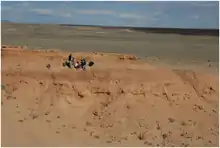 Altan Uul III, a highly fossiliferous location of the formation | |
| Type | Geological formation |
| Sub-units | Lower, Middle and Upper units |
| Underlies | Alluvium |
| Overlies | Barun Goyot Formation |
| Thickness | Over 235 m (771 ft) |
| Lithology | |
| Primary | Shale, sandstone |
| Other | Mudstone, conglomerate |
| Location | |
| Coordinates | 43.5°N 101.0°E |
| Approximate paleocoordinates | 40.8°N 90.2°E |
| Region | Bayankhongor Aimag, Omnogov, Ovorhangai |
| Country | |
| Extent | Gobi Desert |
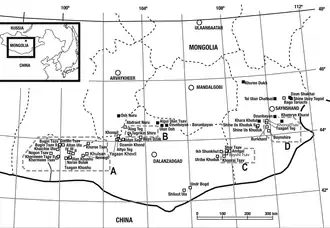 Cretaceous-aged dinosaur fossil localities of Mongolia. Nemegt localities at area A. | |
Description
The Nemegt Formation is composed of mudstones and sandstones that were deposited by ancient lakes, streams, and flood plains. The Altan Uul locality was described by Michael Novacek as "a canyon carved out of a very rich series of sedimentary rocks" with "steep cliffs and narrow washes". The climate associated with it was wetter than when preceding formations were deposited; there seems to have existed at least some degree of forest cover. Fossilized trunks have been also found. These petrified wood, and the remains of Araucariaceae conifers indicate that the forests of the Nemegt were thickly wooded, with a high canopy formed by tall conifer trees. When examined, the rock facies of this formation suggest the presence of stream and river channels, mudflats, and shallow lakes. Sediments also indicate that there existed a rich habitat, offering diverse food in abundant amounts that could sustain massive Cretaceous dinosaurs.[1][2]
Stratigraphy
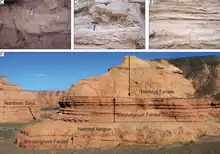
The most recent stratigraphy divides the Nemegt Formation into three informal members. The lower member is dominated by fluvial deposits, while middle and upper members consist of alluvial plain, paludal, lacustrine, and fluvial deposits. The colour of the sediments is usually light grey to tan in colour in comparison to the typically red colour of the underlying Barun Goyot Formation.[3] It overlies and sometimes interfingers with the Barun Goyot Formation. Interfingering has been noted at the stratotype (Red Walls) and Hermiin Tsav.[3] There has been no absolute dating of the Nemegt Formation. Historically the Nemegt has been considered late Campanian to Maastrichtian, based on comparisons of fossils present, but no exact dating has been performed. The age for the underlying Baruungoyot Formation (= Svita) has been suggested as Santonian to Campanian, and Shuvalov (2000) found K-Ar dating of basalts that they referred to the mid and upper Baruungoyot to be 75 to 80 million years old.[4]
Paleobiota of the Nemegt Formation
Color key
|
Notes Uncertain or tentative taxa are in small text; |
Invertebrates
| Genus | Species | Location | Stratigraphic position | Material | Notes | Image |
|---|---|---|---|---|---|---|
| Altanicypris | A. bispinifera | Altan Uul IV, Nemegt | "Complete carapace and left valve."[5] | An ostracod. | ||
| A. multispina | Altan Uul IV, Nemegt | "Nine carapaces and some detached valves."[5] | An ostracod. | |||
| A. szczechurae | Altan Uul IV, Nemegt | "Multiple carapaces and detached valves."[5] | An ostracod. | |||
| Candona | C. altanulaensis | Altan Uul IV, Bügiin Tsav, Nemegt | "Multiple specimens with carapaces and valves."[5] | An ostracod. | ||
| cf. C. fabaeformis | Altan Uul IV, Nemegt | "Several carapaces and deatached valves."[5] | An ostracod. | |||
| Candoniella | C. altanica | Altan Uul IV, Bügiin Tsav, Nemegt | "Multiple specimens with carapaces and valves."[5] | An ostracod. | ||
| C. mordvilkoi | Altan Uul IV | "Three adult carapaces."[6] | An ostracod. | |||
| Cyclocypris | C. transitoria | Bügiin Tsav, Nemegt | "Seven adult carapaces."[5] | An ostracod. | ||
| Cypria | C. elata | Bügiin Tsav, Hermiin Tsav | "Several carapaces and valves."[5] | An ostracod. | ||
| Cypridopsis? | C. bugintsavicus | Altan Uul IV, Bügiin Tsav, Nemegt, Tsagan Khushu | "Ten adult carapaces."[5] | An ostracod. | ||
| Indeterminate | Nemegt | "Several complete carapaces."[5] | An ostracod. | |||
| Cypris? | C. ectypa | Altan Uul IV, Bügiin Tsav, Nemegt, Ulan Bulag | "Complete carapaces and some deatached valves."[5] | An ostracod. | ||
| Cypridea | cf. C. punctilataeformis | Nemegt | "One adult carapace."[6] | An ostracod. | ||
| C. barsboldi | Altan Uul IV, Bügiin Tsav, Nemegt | "Multiple specimens with carapaces and valves."[5] | An ostracod. | |||
| C. cavernosa | Altan Uul IV, Bügiin Tsav, Nemegt, Nogon Tsav | "Multiple specimens with carapaces and valves."[5] | An ostracod. | |||
| C. rostrata | Bügiin Tsav, Nemegt, Nogon Tsav | "Caparaces."[6] | An ostracod. | |||
| Indeterminate | Altan Uul IV, Nemegt | "Five juvenile carapaces."[5] | An ostracod. | |||
| Gobiella | G. prima | Altan Uul IV, Nemegt | "Several carapaces and detached valves."[5] | An ostracod. | ||
| Khandia | K. stankevitchae | Altan Uul IV, Nemegt | "Multiple carapaces and valves."[5] | An ostracod. | ||
| Leiria | Indeterminate | Nemegt | "Several deatached valves."[5] | An ostracod. | ||
| Indeterminate | Nemegt | "Complete carapace."[5] | An ostracod. | |||
| Limnocythere sp. | Indeterminate | Nemegt | "Juvenile carapace."[5] | An ostracod. | ||
| Lycopterocypris? | cf. L. profunda | Altan Uul IV, Nemegt | "Multiple complete carapaces and left valve."[5] | An ostracod. | ||
| Mongolianella | M. palmosa? | Altan Uul IV, Bügiin Tsav, Nemegt | "Several adult carapaces."[5] | An ostracod. | ||
| Mongolocypris | M. distributa | Altan Uul IV, Bügiin Tsav, Nemegt, Tsagan Khushu | "Multiple specimens with complete carapaces and valves."[5] | An ostracod. | ||
| Nemegtia | N. biformata | Altan Uul IV, Bügiin Tsav, Nemegt, Tsagan Khushu | "Multiple complete carapaces and several detached valves."[5] | An ostracod. | ||
| N. obliquecostae | Altan Uul IV, Nemegt | "Multiple carapaces and valves."[5] | An ostracod. | |||
| N. reticulata | Altan Uul IV, Bügiin Tsav, Nemegt, Nogon Tsav, Tsagan Khushu | "Several carapaces and detached valves."[5] | An ostracod. | |||
| Paracypridea? | P. mongolica | Altan Uul IV, Nemegt | "Multiple carapaces and detached valves."[5] | An ostracod. | ||
| Rhinocypris sp. | Indeterminate | Nemegt | "Several carapaces."[5] | An ostracod. | ||
| Scabriculocypris | S. ingenicus? | Altan Uul IV, Bügiin Tsav, Naran Bulag, Nemegt, Tsagan Khushu | "Multiple carapaces and valves."[5] | An ostracod. | ||
| S. rasilis? | Altan Uul IV, Nemegt | "Several carapaces and detached valves."[5] | An ostracod. | |||
| Timiriasevia | cf. T. miaogouensis | Altan Uul IV, Nemegt | "Seven valves."[5] | An ostracod. | ||
| cf. T. opinabilis | Altan Uul IV | "Adult carapace."[6] | An ostracod. | |||
| T. minuscula | Altan Uul IV, Bügiin Tsav, Nemegt | "Multiple specimens with carapaces and valves."[5] | An ostracod. | |||
| T. naranbulakensis | Altan Uul IV, Bügiin Tsav, Nemegt | "Four carapaces and one right valve."[5] | An ostracod. | |||
| Ziziphocypris | Z. costata | Altan Uul IV, Bügiin Tsav, Nemegt | "Fourteen carapaces."[5] | An ostracod. | ||
Maniraptorans
| Genus | Species | Location | Stratigraphic position | Material | Notes | Image |
|---|---|---|---|---|---|---|
| Adasaurus[7] | A. mongoliensis[7] | Bügiin Tsav | "Partial skull and fragmentary postcrania from two specimens."[8] | A dromaeosaurid. |  | |
| Avimimus[9] | A. portentosus[9] | Shar Tsav, Udyn Sayr | "Skull roof with fragmentary body elements."[10] | An avimimid. |  | |
| A. nemegtensis[10] | Nemegt | "Fragmented skull with partial skeleton."[10] | An avimimid. | |||
| Borogovia[11] | B. gracilicrus[11] | Altan Uul IV | "Partial hindlimbs."[11] | A troodontid. | ||
| Brodavis[12] | B. mongoliensis[12] | Bügiin Tsav | "Nearly complete left tarsometatarsus."[12] | A hesperornithine. | ||
| Elmisaurus[13] | E. rarus[13] | Altan Uul II, Hermiin Tsav, Nemegt | "Fragmentary skull and partially complete skeletons from several specimens."[10] | A caenagnathid. | 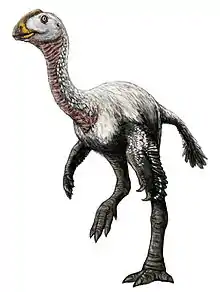 | |
| Gobiraptor[14] | G. minutus[14] | Altan Uul III | "Partial crania with complete lower jaws and fragmented postcrania."[14] | An oviraptorid. | ||
| Gurilynia[15] | G. nessovi[15] | Guriliin Tsav | "Left coracoid and partial humerii."[15] | An enantiornithine. | ||
| Judinornis[16] | J. nogontsavensis[16] | Nogon Tsav | "Dorsal vertebra."[16] | A hesperornithine. | ||
| Laevisoolithus[17] | L. sochavai | "Whole egg with partly broken pole"[17] | Laid by a bird or small theropod.[17] | |||
| Mononykus[18] | M. olecranus[18] | Bügiin Tsav | "Fragmentary skull, vertebrae, limbs and fragmented pelvis."[19] | An alvarezsaurid. | 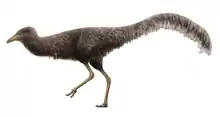 | |
| Mononykus cf. | Indeterminate | Altan Uul III | "Caudal vertebrae and left hindlimb."[20] | An alvarezsaurid. | ||
| Nemegtomaia[21] | N. barsboldi[21] | Nemegt | "Multiple specimens including a nesting specimen and eggs."[22] | An oviraptorid also present in the Barun Goyot Formation. |  | |
| Nemegtonykus[20] | N. citus[20] | Altan Uul III | "Partially complete skeleton from two specimens lacking the skull."[20] | An alvarezsaurid. | ||
| Nomingia[23] | N. gobiensis[23] | Bügiin Tsav, Nemegt | "Vertebral series with partial hindlimbs and a referred pygostyle."[10] | An oviraptorid. | 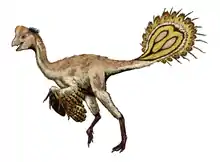 | |
| Oksoko[24] | O. avarsan | Bügiin Tsav, Guriliin Tsav | "Multiple associated skeletons."[24] | An oviraptorid. | ||
| Rinchenia[25] | R. mongoliensis[25] | Altan Uul II | "Skull with nearly complete skeleton."[10] | An oviraptorid. |  | |
| Subtiliolithus[17] | S. microtuberculatus[17] | "Eggshell fragments"[17] | ||||
| Teviornis[26] | T. gobiensis[26] | Guriliin Tsav | "Partial forelimbs."[26] | An anseriform. | ||
| Therizinosaurus[27] | T. cheloniformis[27] | Altan Uul, Hermiin Tsav, Nemegt | Upper White Beds of Hermiin Tsav | "Two specimens with forelimb elements and one with a referred hindlimb."[28] | A giant therizinosaurid. |  |
| Tochisaurus[29] | T. nemegtensis[29] | Nemegt | "Left metatarsus."[29] | A troodontid. | ||
| Undescribed therizinosaurids | Indeterminate | Altan Uul, Bügiin Tsav, Guriliin Tsav, Ulan Khushu | "Partial remains."[30] | Therizinosaurid remains. | ||
| Unnamed ornithurans | Indeterminate | Tsagan Khushu | "A humerus and two tibiotarsi."[31] | Ornithuran remains. | ||
| Zanabazar[32] | Z. junior[33] | Bügiin Tsav | "Skull with fragmentary postcranial skeleton."[32] | A troodontid originally identified as "Saurornithoides junior". |  | |
Ornithomimosaurs
| Genus | Species | Location | Stratigraphic position | Material | Notes | Image |
|---|---|---|---|---|---|---|
| Anserimimus[34] | A. planinychus[34] | Bügiin Tsav | "Partial skeleton lacking the skull."[34][35] | An ornithomimid. |  | |
| Deinocheirus[36] | D. mirificus[36] | Altan Uul III-IV, Bügiin Tsav | Upper Nemegt Beds | "Complete skull with virtually complete postcranial remains from three specimens."[37] | A giant deinocheirid. | 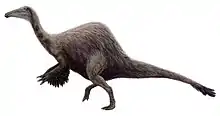 |
| Gallimimus[38] | G. bullatus[38] | Presence in most localities[39] | "Multiple specimens with nearly complete skull and postcranial elements."[39][40] | An ornithomimid. |  | |
| Unnamed ornithomimid[41] | Indeterminate | Tsagan Khushu | "Partial vertebral column with fore and hindlimbs."[41][39] | An ornithomimid. | ||
Tyrannosaurs
| Genus | Species | Location | Stratigraphic position | Material | Notes | Image |
|---|---|---|---|---|---|---|
| Alioramus[42] | A. remotus[42] | Nogon Tsav | "Partially preserved skull with very sparse postcranial remains."[42] | An alioramin. |  | |
| A. altai[43] | Tsagan Khushu | "Nearly complete skull with partial postcrania."[43] | An alioramin. | |||
| Bagaraatan[44] | B. ostromi[44] | Nemegt | "Fragmentary lower jaw, hindlimb and caudal vertebrae."[44] | A tyrannosauroid. | ||
|
R. kreigsteni[45] |
"Nearly complete skeleton including the skull."[45] | A tyrannosaurid that could be a juvenile Tarbosaurus.[46] | 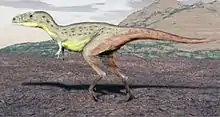 | |||
| Tarbosaurus[47] | T. bataar[48] | Presence in most localities[2] | "Nearly complete skeletons from multiple specimens."[47][48][2] | A large tyrannosaurid. |  | |
Cerapods
| Genus | Species | Location | Stratigraphic position | Material | Notes | Image |
|---|---|---|---|---|---|---|
| Barsboldia[49] | B. sicinskii[49] | Nemegt | "Partial vertebrae, pelvis, and ribs."[49][50] | A hadrosaurid. | .jpg.webp) | |
| Homalocephale[51] | H. calathoceros[51] | Nemegt | "Partial skull and skeleton including hindlimbs."[51] | A pachycephalosaurid. |  | |
| Prenocephale[51] | P. prenes[51] | Bügiin Tsav, Guriliin Tsav, Nemegt, Tsagan Khushu | "Complete skull and partial postcranium of several specimens."[51][52] | A pachycephalosaurid. | 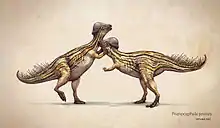 | |
| Saurolophus[53] | S. angustirostris[54] | Presence in most localities[55] | "Multiple specimens, including articulated skulls and postcranial skeletons."[56][57][58] | A hadrosaurid. |  | |
Ankylosaurids
| Genus | Species | Location | Stratigraphic position | Material | Notes | Image |
|---|---|---|---|---|---|---|
| "Dyoplosaurus"[59] | "D". giganteus[59] | Nemegt | "Caudal vertebrae, partial feet, osteoderms and a partial tail club."[60] | An ankylosaurid now regarded as nomen dubium. | ||
| Saichania[61] | S. chulsanensis[61] | Altan Uul IV | "Partial vertebrae, tail club, and osteoderms."[62] | An ankylosaurid also present in the Barun Goyot Formation. | ||
| Tarchia[61] | T. teresae[62] | Altan Uul IV, Hermiin Tsav I | "Skull, partial body elements vertebrae, partial limbs and tail club"[62] | An ankylosaurid. | ||
| Undescribed ankylosaurids | Indeterminate | Altan Uul II-III-IV, Bügiin Tsav, Hermiin Tsav I, Khuree Tsav, Nemegt | "Several body elements including vertebrae and osteoderms."[60] | Ankylosaurid remains. | ||
| Unnamed ankylosaurid | Indeterminate | Altan Uul III | "Partial pelvis, caudal vertebrae, tail, osteoderms and skin impressions."[60] | An ankylosaurid. |  | |
Sauropods
| Genus | Species | Location | Stratigraphic position | Material | Notes | Image |
|---|---|---|---|---|---|---|
| Nemegtosaurus[63] | N. mongoliensis[63] | Nemegt | "Skulls and body remains from several specimens."[64][65][66] | A titanosaur. | 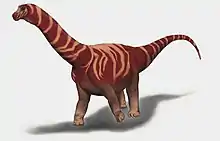 | |
| Opisthocoelicaudia[67] | O. skarzynskii[67] | Altan Uul IV | "Nearly complete skeleton without the skull and cervical series."[65] | A titanosaur. |  | |
| Undescribed sauropods | Indeterminate | Altan Uul I-II-II-IV, Bügiin Tsav, Guriliin Tsav, Hermiin Tsav, Khamaryn Khural, Khuree Tsav, Nemegt, Nogon Tsav, Tsagan Khushu, Ulan Khushu | "Several fragmentary remains."[65] | Sauropod remains that may represent already named taxa. | ||
Pterosaurs
| Genus | Species | Location | Stratigraphic position | Material | Notes | Image |
|---|---|---|---|---|---|---|
| Unnamed azhdarchid | Indeterminate | Guriliin Tsav | "Fragmentary cervical vertebrae."[68] | A giant azhdarchid |  | |
Crocodylomorphs
| Genus | Species | Location | Stratigraphic position | Material | Notes | Image |
|---|---|---|---|---|---|---|
| Paralligator[69] | P. gradilifrons[69] | Nemegt, Nogon Tsav, Ulaan Bulag | "Partially complete skulls with sparse body elements."[69] | A paralligatorid. | 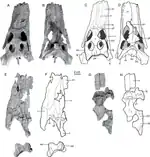 | |
Mammals
| Genus | Species | Location | Stratigraphic position | Material | Notes | Image |
|---|---|---|---|---|---|---|
| Buginbaatar[70] | B. transaltaiensis[70] | Bügiin Tsav | "Fragmentary skull."[70] | A multituberculate. | ||
| "Gurlin Tsav skull" | Indeterminate | A mysterious metatherian, possibly a sparassodont. | ||||
See also
- Djadochta Formation
- List of dinosaur-bearing rock formations
- List of fossil sites
- Nemegt Basin
References
- Novacek, M. (1996). Dinosaurs of the Flaming Cliffs. Bantam Doubleday Dell Publishing Group Inc. New York, New York. ISBN 978-0-385-47775-8
- Owocki, K.; Kremer, B.; Cotte, M.; Bocherens, H. (2020). "Diet preferences and climate inferred from oxygen and carbon isotopes of tooth enamel of Tarbosaurus bataar (Nemegt Formation, Upper Cretaceous, Mongolia)". Palaeogeography, Palaeoclimatology, Palaeoecology. 537: 109190. Bibcode:2020PPP...537j9190O. doi:10.1016/j.palaeo.2019.05.012.
- Eberth, David A. (1 April 2018). "Stratigraphy and paleoenvironmental evolution of the dinosaur-rich Baruungoyot-Nemegt succession (Upper Cretaceous), Nemegt Basin, southern Mongolia". Palaeogeography, Palaeoclimatology, Palaeoecology. 494: 29–50. doi:10.1016/j.palaeo.2017.11.018.
- Shuvalov, V.F. (2000). "The Cretaceous stratigraphy and palaeobiogeography of Mongolia". In Benton, Michael J.; Shishkin, Mikhail A.; Unwin, D.M.; Kurochkin, E.N. (eds.). The Age of Dinosaurs in Russia and Mongolia. Cambridge University Press. pp. 256–278. ISBN 0-521-55476-4.
- Szczechura, J. (1978). "Fresh-water ostracodes from the Nemegt Formation (Upper Cretaceous) of Mongolia" (PDF). Paleontologia Polonica. 38: 65−121.
- Szczechura, J.; Blaszyk, J. (1970). "Fresh-water Ostracoda from the Upper Cretaceous of the Nemegt Basin, Gobi Desert" (PDF). Paleontologia Polonica. 21: 107−120.
- Barsbold, R. (1983). "Хищные динозавры мела Монголии" [Carnivorous dinosaurs from the Cretaceous of Mongolia] (PDF). Transactions of the Joint Soviet-Mongolian Paleontological Expedition (in Russian). 19: 5−119. Translated paper
- Turner, A. H.; Makovicky, P. J.; Norell, M. A. (2012). "A Review of Dromaeosaurid Systematics and Paravian Phylogeny". Bulletin of the American Museum of Natural History. 371 (371): 19−22. doi:10.1206/748.1. hdl:2246/6352.
- Kurzanov, S. M. (1981). "An unusual theropod from the Upper Cretaceous of Mongolia". Transactions of the Joint Soviet Mongolian Paleontological Expedition. 15: 39–49.
- Funston, G. F.; Mendonca, S. E.; Currie, P. J.; Barsbold, R.; Barsbold, R. (2018). "Oviraptorosaur anatomy, diversity and ecology in the Nemegt Basin". Palaeogeography, Palaeoclimatology, Palaeoecology. 494: 101−120. Bibcode:2018PPP...494..101F. doi:10.1016/j.palaeo.2017.10.023.
- Osmólska, H. (1987). "Borogovia gracilicrus gen. et sp. n., a new troodontid dinosaur from the Late Cretaceous of Mongolia" (PDF). Acta Palaeontologica Polonica. 32: 133−150.
- Martin, L. D.; Kurochkin, E. N.; Tokaryk, T. T. (2012). "A new evolutionary lineage of diving birds from the Late Cretaceous of North America and Asia". Palaeoworld. 21 (1): 59−63. doi:10.1016/j.palwor.2012.02.005.
- Osmólska, H. (2000). "Coossified tarsometatarsi in theropod dinosaurs and their bearing on the problem of bird origins" (PDF). Palaeontologica Polonica. 42: 79–95.
- Lee, S.; Lee, Y. N.; Chinsamy, A.; Lü, J.; Barsbold, R.; Tsogtbaatar, K. (2019). "A new baby oviraptorid dinosaur (Dinosauria: Theropoda) from the Upper Cretaceous Nemegt Formation of Mongolia". PLOS ONE. 14 (2): e0210867. doi:10.1371/journal.pone.0210867. PMC 6364893. PMID 30726228.
- Kurochkin, E. N. (1999). "A new large enantiornithid from the Late Cretaceous of Mongolia". In Darevskii, I.; Averianov, A. (eds.). Materials on the History of Fauna of Eurasia. 277. Saint Petersburg: Zoological Institute of the Russian Academy of Sciences. pp. 132−127.
- Nessov, L.; Borkin, L. J. (1983). "New records of bird bones from Cretaceous of Mongolia and Middle Asia". Trudy Zoologicheskogo Instituta AN SSSR. 116: 108–110.
- K. E. Mikhailov. 1991. Classification of fossil eggshells of amniotic vertebrates. Acta Palaeontologica Polonica 36(2):193-238
- Perle, A.; Norell, M. A.; Chiappe, L. M.; Clark, J. M. (1993). "Correction: Flightless bird from the Cretaceous of Mongolia". Scientific Reports. 363 (188). doi:10.1038/363188a0.
- Perle, A.; Chiappe, L. M.; Rinchen, B.; Clark, J. M.; Norell, M. A. (1994). "Skeletal morphology of Mononykus olecranus (Theropoda, Avialae) from the late Cretaceous of Mongolia". American Museum Novitates (3105): 1−29. hdl:2246/4936.
- Lee, S.; Park, J.-Y.; Lee, Y.-N.; Kim, S.-H.; Lü, J.; Barsbold, R.; Tsogtbaatar, K. (2019). "A new alvarezsaurid dinosaur from the Nemegt Formation of Mongolia". Scientific Reports. 9 (1): 15493. Bibcode:2019NatSR...915493L. doi:10.1038/s41598-019-52021-y. PMC 6820876. PMID 31664171.
- Lü, J.; Tomida, Y.; Azuma, Y.; Dong, Z.; Lee, Y.-N. (2005). "Nemegtomaia gen. nov., a replacement name for the oviraptorosaurian dinosaur Nemegtia Lü et al. 2004, a preoccupied name". Bulletin of the National Science Museum, Tokyo, Series C. 31: 51.
- Fanti, F.; Currie, P. J.; Badamgarav, D.; Lalueza-Fox, C. (2012). "New specimens of Nemegtomaia from the Baruungoyot and Nemegt Formations (Late Cretaceous) of Mongolia". PLOS ONE. 7 (2): e31330. Bibcode:2012PLoSO...731330F. doi:10.1371/journal.pone.0031330. PMC 3275628. PMID 22347465.
- Barsbold, R.; Osmólska, H.; Watabe, M.; Currie, P. J.; Tsogtbaatar, K. (2000). "New Oviraptorosaur (Dinosauria, Theropoda) From Mongolia: The First Dinosaur With A Pygostyle" (PDF). Acta Palaeontologica Polonica. 45 (2): 97–106.
- Gregory F. Funston; Tsogtbaatar Chinzorig; Khishigjav Tsogtbaatar; Yoshitsugu Kobayashi; Corwin Sullivan; Philip J. Currie (2020). "A new two-fingered dinosaur sheds light on the radiation of Oviraptorosauria". Royal Society Open Science. 7 (10): Article ID 201184. doi:10.1098/rsos.201184.
- Barsbold, R. (1997). "Oviraptorosauria". In Currie, P. J.; Padian, K. (eds.). Encyclopedia of Dinosaurs. Oxford, UK: Academic Press. pp. 505–508.
- Kurochkin, E. N.; Dyke, G. J.; Karhu, A. A. (2002). "A new presbyornithid bird (Aves, Anseriformes) from the late Cretaceous of southern Mongolia". American Museum Novitates (3386): 1–11. hdl:2246/2875.
- Maleev, E. A. (1954). "Noviy cherepachoobrazhniy yashcher v Mongolii" [New turtle−like reptile in Mongolia]. Priroda (3): 106−108. Translated paper
- Zanno, L. E. (2010). "A taxonomic and phylogenetic re-evaluation of Therizinosauria (Dinosauria: Maniraptora)". Journal of Systematic Palaeontology. 8 (4): 503−543. doi:10.1080/14772019.2010.488045.
- Kurzanov, S. M.; Osmólska, H. (1991). "Tochisaurus nemegtensis gen. et sp. n., a new troodontid (Dinosauria, Theropoda) from Mongolia" (PDF). Acta Palaeontologica Polonica. 36: 69–76.
- Lee, Y.-N.; Barsbold, R.; Currie, P. J. (2008). "A short report of Korea-Mongolia International Dinosaur Project (1st and 2nd year)". Journal of Vertebrate Paleontology. 28 (supp. 003): 104A–105A. doi:10.1080/02724634.2008.10010459.
- Clarke, J. A.; Norell, M. A. (2004). "New avialan remains and a review of the known avifauna from the late Cretaceous Nemegt Formation of Mongolia". American Museum Novitates (3447): 1−12. hdl:2246/2812.
- Norell, M. A.; Makovicky, P. J.; Bever, G. S.; Balanoff, A. M.; Clark, J. M.; Barsbold, R.; Rowe, T. (2009). "A review of the Mongolian Cretaceous dinosaur Saurornithoides (Troodontidae, Theropoda)". American Museum Novitates (3654): 1−63. doi:10.1206/648.1. hdl:2246/5973.
- Barsbold, R. (1974). "Saurornithoididae, a new family of small theropod dinosaurs from Central Asia and North America" (PDF). Palaeontologica Polonica. 30: 5−22.
- Barsbold, R. (1998). "A new Late Cretaceous ornithomimid from the Mongolian People's Republic". Paleontological Journal. 22: 124−127.
- Bronowicz, R. (2005). Upper Cretaceous dinosaur Anserimimus planinychus (Theropoda: Ornithomimidae) from Mongolia (MS thesis). University of Warsawy.
- Osmólska, H.; Roniewicz, E. (1970). "Deinocheiridae, a new family of theropod dinosaurs" (PDF). Palaeontologica Polonica (21): 5−19.
- Lee, Y.-N.; Barsbold, R.; Currie, P. J.; Kobayashi, Y.; Lee, H.-J.; Godefroit, P.; Escuillié, F.; Tsogtbaatar, C. (2014). "Resolving the long-standing enigmas of a giant ornithomimosaur Deinocheirus mirificus". Nature. 515 (7526): 257−260. Bibcode:2014Natur.515..257L. doi:10.1038/nature13874. PMID 25337880.
- Osmólska, H.; Roniewicz, E.; Barsbold, R. (1972). "A new dinosaur, Gallimimus bullatus n. gen., n. sp. (Ornithomimidae) from the Upper Cretaceous of Mongolia" (PDF). Palaeontologia Polonica. 27: 103−143.
- Chinzorig, T.; Kobayashi, Y.; Tsogtbaatar, K.; Currie, P. J.; Takasaki, R.; Tanaka, T.; Iijima, M.; Barsbold, R. (2018). "Ornithomimosaurs from the Nemegt Formation of Mongolia: manus morphological variation and diversity". Palaeogeography, Palaeoclimatology, Palaeoecology. 494: 91–100. doi:10.1016/j.palaeo.2017.10.031.
- Lee, H.-J.; Lee, Y.-N.; Adams, T. L.; Currie, P. J.; Kobayashi, Y.; Jacobs, L. L.; Koppelhus, E. B. (2018). "Theropod trackways associated with a Gallimimus foot skeleton from the Nemegt Formation, Mongolia". Palaeogeography, Palaeoclimatology, Palaeoecology. 494: 160–167. Bibcode:2018PPP...494..160L. doi:10.1016/j.palaeo.2017.10.020.
- Bronowicz, R. (2011). "New material of a derived ornithomimosaur from the Upper Cretaceous Nemegt Formation of Mongolia". Acta Palaeontologica Polonica. 56 (3): 477−488. doi:10.4202/app.2009.1123.
- Kurzanov, S. M. (1976). "A new carnosaur from the Late Cretaceous of Nogon-Tsav, Mongolia". The Joint Soviet-Mongolian Paleontological Expedition Transactions (in Russian). 3: 93−104.
- Brusatte, S. L.; Carr, T. D.; Erickson, G. M.; Bever, G. S.; Norell, M. A. (2009). "A long snouted, multihorned tyrannosaurid from the Late Cretaceous of Mongolia". PNAS. 106 (41): 17261−17266. doi:10.1073/pnas.0906911106. PMC 2765207. PMID 19805035.
- Osmolska, H. (1996). "An unusual theropod dinosaur from the Late Cretaceous Nemegt Formation of Mongolia" (PDF). Acta Palaeontologica Polonica. 41 (1): 1−38.
- Sereno, P.; Tan, L.; Brusatte, S. L.; Kriegstein, H. J.; Zhao, X.; Cloward, K. (2009). "Tyrannosaurid skeletal design first evolved at small body size". Science. 326 (5951): 418−422. Bibcode:2009Sci...326..418S. doi:10.1126/science.1177428. PMID 19762599.
- Fowler, D. W.; Woodward, H. N.; Freedman, E. A.; Larson, P. L.; Horner, J. R. (2011). "Reanalysis of Raptorex kriegsteini: A Juvenile Tyrannosaurid Dinosaur from Mongolia". PLOS ONE. 6 (6): e21376. Bibcode:2011PLoSO...6E1376F. doi:10.1371/journal.pone.0021376. PMC 3126816. PMID 21738646.
- Maleev, E. A. (1955). "New carnivorous dinosaurs from the Upper Cretaceous of Mongolia". Doklady Akademii Nauk SSSR. 104 (5): 779−783. Translated paper
- Rozhdestvensky, A. K. (1965). "Growth changes in Asian dinosaurs and some problems of their taxonomy". Paleontological Journal (in Russian). 3: 95−109.
- Maryańska, T.; Osmólska, H. (1981). "First lambeosaurine dinosaur from the Nemegt Formation, Upper Cretaceous, Mongolia" (PDF). Acta Palaeontologica Polonica. 26 (3–4): 243–255.
- Prieto-Márquez, A. (2011). "A reapprisal of Barsboldia sicinskii (Dinosauria: Hadrosauridae) from the Late Cretaceous of Mongolia". Journal of Paleontology. 85 (3): 468–477. doi:10.1666/10-106.1. JSTOR 23020183.
- Maryańska, T.; Osmólska, H. (1974). "Pachycephalosauria, a new suborder of ornithischian dinosaurs" (PDF). Palaeontologica Polonica. 30: 45−102.
- Evans, D. C.; Hayashi, S.; Chiba, K.; Watabe, M.; Ryan, M. J.; Lee, Y.-N.; Currie, P. J.; Tsogtbaatar, K.; Barsbold, R. (2018). "Morphology and histology of new cranial specimens of Pachycephalosauridae (Dinosauria: Ornithischia) from the Nemegt Formation, Mongolia". Palaeogeography, Palaeoclimatology, Palaeoecology. 494: 121−134. Bibcode:2018PPP...494..121E. doi:10.1016/j.palaeo.2017.11.029.
- Brown, B. (1912). "A crested dinosaur from the Edmonton Cretaceous". Bulletin of the American Museum of Natural History. 31 (14): 131–136. hdl:2246/1401.
- Rozhdestvensky, A. K. (1952). "ru:Новый представитель утконосых динозавров из верхнемеловых отложений Монголии" [A new representative of the duck-billed dinosaurs from the Upper Cretaceous deposits of Mongolia]. Doklady Akademii Nauk SSSR (in Russian). 86 (2): 405–408.
- Fanti, F.; Bell, P. R.; Currie, P. J.; Tsogtbataar, K. (2020). "The Nemegt Basin — One of the best field laboratories for interpreting Late Cretaceous terrestrial ecosystems". Palaeogeography, Palaeoclimatology, Palaeoecology. 494: 1−4. doi:10.1016/j.palaeo.2017.07.014.
- Bell, P. R. (2011). "Cranial osteology and ontogeny of Saurolophus angustirostris from the Late Cretaceous of Mongolia with comments on Saurolophus osborni from Canada". Acta Palaeontologica Polonica. 56 (4): 703–722. doi:10.4202/app.2010.0061.
- Bell, P. R. (2012). "Standardized Terminology and Potential Taxonomic Utility for Hadrosaurid Skin Impressions: A Case Study for Saurolophus from Canada and Mongolia". PLOS ONE. 7 (2): e31295. doi:10.1371/journal.pone.0031295. PMC 3272031. PMID 22319623.
- Dewaele, L.; Tsogtbaatar, K.; Barsbold, R.; Garcia, G.; Stein, K.; Escuillie, F.; Godefroit, P. (2015). "Perinatal specimens of Saurolophus angustirostris (Dinosauria: Hadrosauridae), from the Upper Cretaceous of Mongolia". PLOS ONE. 10 (10): e0138806. doi:10.1371/journal.pone.0138806. PMC 4605499. PMID 26466354.
- Maleev, E. A. (1956). "Armored dinosaurs of the Upper Cretaceous of Mongolia, Family Ankylosauridae". Trudy Palaeontologicheskoi Instytuta, Akademiia Nauk SSSR (in Russian). 62: 51–91. Translated paper
- Arbour, V. M.; Currie, P. J.; Badamgarav, D. (2014). "The ankylosaurid dinosaurs of the Upper Cretaceous Baruungoyot and Nemegt formations of Mongolia". Zoological Journal of the Linnean Society. 172 (3): 631–652. doi:10.1111/zoj.12185.
- Maryańska, T. (1977). "Ankylosauridae (Dinosauria) from Mongolia" (PDF). Palaeontologia Polonica. 37: 85–151.
- Penkalski, P.; Tumanova, T. (2017). "The cranial morphology and taxonomic status of Tarchia (Dinosauria: Ankylosauridae) from the Upper Cretaceous of Mongolia". Cretaceous Research. 70: 117−127. doi:10.1016/j.cretres.2016.10.004.
- Nowinski, A. (1971). "Nemegtosaurus mongoliensis n. gen., n. sp. (Sauropoda) from the uppermost Cretaceous of Mongolia" (PDF). Palaeontologica Polonica. 25: 57−81.
- Wilson, J. A. (2005). "Redescription of the Mongolian sauropod Nemegtosaurus mongoliensis Nowinski (Dinosauria: Saurischia) and comments on Late Cretaceous sauropod diversity". Journal of Systematic Palaeontology. 3 (3): 283−318. doi:10.1017/S1477201905001628.
- Currie, P. J.; Wilson, J. A.; Fanti, F.; Mainabayar, B.; Tsogtbaatar, K. (2017). "Rediscovery of the type localities of the Late Cretaceous Mongolian sauropods Nemegtosaurus mongoliensis and Opisthocoelicaudia skarzynskii: Stratigraphic and taxonomic implications". Palaeogeography, Palaeoclimatology, Palaeoecology. 494: 5−13. Bibcode:2018PPP...494....5C. doi:10.1016/j.palaeo.2017.10.035.
- Averianov, A.; Lopatin, A. (2019). "A possible new specimen of the Late Cretaceous Mongolian sauropod Nemegtosaurus and sauropod diversity in the Nemegt Formation". Acta Palaeontologica Polonica. 64 (2): 313−321. doi:10.4202/app.00596.2019.
- Borsuk-Białynicka, M. M. (1977). "A new camarasaurid sauropod Opisthocoelicaudia skarzynskii gen. n., sp. n. from the Upper Cretaceous of Mongolia" (PDF). Palaeontologia Polonica. 37 (5): 5–64.
- Tsuihiji, T.; Andres, B.; O'connor, P. M.; Watabe, M.; Tsogtbaatar, K.; Mainbayar, B. (2017). "Gigantic pterosaurian remains from the Upper Cretaceous of Mongolia". Journal of Vertebrate Paleontology. 37 (5). doi:10.1080/02724634.2017.1361431.
- Turner, A. H. (2015). "A Review of Shamosuchus and Paralligator (Crocodyliformes, Neosuchia) from the Cretaceous of Asia". PLOS ONE. 10 (2): e0118116. Bibcode:2015PLoSO..1018116T. doi:10.1371/journal.pone.0118116. PMC 4340866. PMID 25714338.
- Kielan-Jaworowska, Z.; Sochava, A. V. (1969). "The first multituberculate from the Uppermost Cretaceous of the Gobi Desert (Mongolia)" (PDF). Acta Palaeontologica Polonica. 14 (3): 355−367.